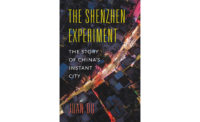Views of the City
The only constant is change.
Over the great bridge, with the sunlight through the girders making a constant flicker upon the moving cars, with the city rising up across the river in white heaps…the city seen for the first time, in its first wild promise of all the mystery and the beauty in the world. — F. Scott Fitzgerald, The Great Gatsby

I never tire of the New York skyline. It looks fresh on every return to the city, in every kind of weather and at every time of day, gleaming or gray, but always thrilling and full of that promise and mystery.
But in the weeks and months after September 11, the skyline became unbearably sad, bereft of the Twin Towers that had anchored the southern end of Manhattan like immense minimalist sculptures against a vast field of blue or cloud — beautiful at a distance in a way they never were up close. Their shocking disappearance was a powerful symbol of what had been lost — all the innocent lives as well as the innocence of the nation. Despite the immediate call by political leaders to rebuild, most New Yorkers were too stunned to think about what the city would become. It would survive, but what next?
Ten years after the terrorist attacks, as we remember those who lost their lives, we can’t help but marvel at New York today. The decade has been a golden age for the city, a renaissance in architecture and urban design. World-class architects have come to build in New York — Norman Foster, Renzo Piano, Frank Gehry, Yoshio Taniguchi, Kazuyo Sejima and Ryue Nishizawa, Thom Mayne, Jean Nouvel, and Herzog & de Meuron. High-profile local firms have landed big projects on their home turf, while emerging architects have had new opportunities in both private and civic design.
Most remarkable has been the huge investment in the public realm. The High Line, the park created on a derelict elevated rail bed, is the most famous new public space, a tourist magnet that has drawn 5 million visitors since its first phase opened in the summer of 2009. Less publicized is the fact that since Mayor Michael Bloomberg took office in January 2002, the city has created more parkland — nearly 700 acres — than in any time since the era of Robert Moses in the 1930s. Many of the new parks show the power of rich collaborations between landscape architects and architects — such as the High Line itself, designed by a team led by James Corner Field Operations and Diller Scofidio + Renfro.
The seeds for this burst of urban regeneration were planted in the 1990s, with the bid to bring the 2012 Olympics to New York. Created under planner Alexander Garvin, the Olympics proposal called for athletic facilities — both new and renovated structures — to be placed throughout the five boroughs, to revitalize flagging neighborhoods long after the Games were over. When Daniel Doctoroff, the leader of the Olympics effort, became deputy mayor for economic development in 2002, many of those ideas infiltrated the plans for the city going forward, even after the 2012 bid was lost to London.
But it was also the aftermath of 9/11 that catalyzed the public desire for superior design and planning, a shout from ordinary New Yorkers who crowded into community meetings and spoke powerfully about what should be built at Ground Zero. After 4,000 people came together at the Javits Convention Center one summer’s day in 2002 and roundly rejected the first, banal designs for the World Trade Center site, public officials were forced to hold an international design competition to try to corral the best ideas for those 16 acres.
Jane Jacobs, the late urbanist, whose famous book inspired the title of this issue, might not have been surprised that the rebuilding of Ground Zero has turned out to be a mixed success, with politics and real estate trumping the best intentions. And with a soaring economy and a big push for development under the Bloomberg administration, the decade brought aggressive change to many neighborhoods throughout the city — occasionally to the alarm of critics and communities, as in the case of the controversial Atlantic Yards arena project in Brooklyn.
Yet it’s mostly been a vibrant time for architecture and urban design. Though the economy is shaky once again, the legacy of the last 10 years is everywhere — in the new waterfront parks and bike lanes, in the sparkling cultural centers, and in the planting of half a million new trees. While we remember 9/11, we also celebrate the transformation and life of a great American city.




